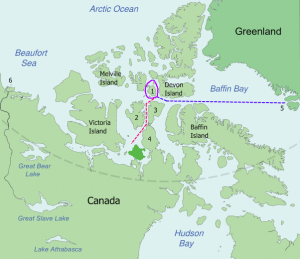Early polar exploration…explored

“Man proposes, God disposes” 1864 painting by Sir Edwin Henry Landseer (1802-1873)
Said to reference the fate of Franklin’s Lost Expedition. (source: Wikipedia, creative commons)
CBC is reporting that marine archeologists with Parks Canada hope to be back in Arctic waters this summer, looking for Franklin expedition ships Erebus and Terror. The ships were abandoned in 1848 after being trapped by ice for 19 months while seeking the Northwest passage. Modern searchers think they have a decent shot at estimating where the ships could be, but it’s still an enormous haystack for two very small needles.
Assuming this summer’s trip does happen it will be the third successive try for the Parks Canada team, following searches conducted in 2011 and 2012. Previous efforts have found artifacts of interest, but have failed thus far to locate the sunken ships. (CBC has a full coverage page that will undoubtably be updated as events develop this summer.)
Good luck avoiding cliches when writing or reading about this topic: ill-fated expedition, human tragedy, enduring mystery. It’s all there, including new developments that string interest along. Franklin expedition sailors may have died from disease (including TB and scurvy) along with starvation and exposure. But exhumation of known graves in the 1980’s gave rise to a new theory that crew members also suffered from lead poisoning – caused by improperly-tinned food.
Now new findings by lead author Western University chemistry professor Ron Martin (and four co-authors) challenge that view. The study (“Pb distribution in bones from the Franklin expedition: synchrotron X-ray fluorescence and laser ablation/mass spectroscopy“) was published in the journal Applied Physics A: Materials Science and Processing. The first two pages can be seen for free, access to the full study requires a fee. As reported in April of this year by the Canadian Press the study tends to deflate the lead-poisoning theory:
The wide distribution and high concentrations of lead in the measured bones is indicative of long-term exposure before the start of the expedition, says the paper. The lead distribution is essentially uniform as might be expected from lifetime lead ingestion. There is no evidence for a sudden massive increase in lead during the latter part of any individual’s life.
The June 26th article from the CBC speaks to why so many find this story worth following:
“To me it just becomes more and more puzzling,” says Martin. “They had a lot of lead in them, but they had a lot of lead in them when they arrived. It’s a mystery within a mystery within a mystery. What I want to know is where all the lead came from in the first place.”

Probable routes of HMS Erebus and HMS Terror. Map via Wikipedia.
So far this post reads like something for the In Box, with lots of links to actual news. But now we’ll move it to All In territory by asking a bunch of questions.
Why was exploring polar regions so engaging in the Victorian age? Sure, in many respects it was 19th century England’s space program. But was there more to it than that?
Turning to modern times, why are so many still interested in what happened to the Franklin expedition?
For me I guess it comes down to astonishment at the hubris of those who sallied forth ill-prepared and over-confident. And vast admiration for those who figured out the best approach, which usually involved moving beyond cultural bias to include whatever actually worked. (Yes, back in the day dog teams beat pony or motorized sleds over ice by far! Knowing how to ski was handy too.)
Adaptability is a very useful trait, worth more study and respect.
Indeed, one aspect of Arctic exploration that interests me is how long it took for Europeans to properly appreciate the amazing survival skills of indigenous populations in the far north, and how long it took to credit native oral accounts of what happened to the stranded crew from Franklin’s expedition.
I fear it all smacks of cultural arrogance at best, or barely-disguised racism at worst. Much as we’d like to think that’s all bad stuff left behind now, I rather suspect cultural arrogance and perhaps some racism are still factors when outsiders deal with people of the Arctic region.
Do you like tales of polar exploration? What draws you to them?
Bonus question: who are your favorite polar explorers (native or non-native) and why? Or, books about the 19th century world of polar exploration?
Tags: Arctic, canada, Franklin Expedition, history, Parks Canada, polar exploration, Ron Martin





.png)


Why the fascination? Well, for me, it started casually, on a slightly personal note, when I learned that Lady Jane had lingered and paced the streets of my little town in Alaska while expeditions searched for her husband.
Then I discovered a map dealer with collections of the very (flawed) maps that led the NW Passage explorers to their doom (cliche acknowledged). Ohmigosh, who could resist such maps? I bought them, traced where the last whaler saw the expedition, where the graves were found, where Arctic natives reported sightings.
Gradually, I found myself driving into the weeds: How were tinned foods sealed in the 19th century? What were the trade imperatives driving the search for a NW passage? How long could a timbered ship withstand the pressures of ice? What were the personalities, the moral and cultural expectations of these men? Even (heaven help me) what were/are the nutrient advantages of seal blubber???
In short, obsession grows slowly in intensity (and in the required amount shelf-space in your house). Unfortunately, the number of friends and relatives willing to converse on the topic gradually diminishes in proportion. But, happily, we occasionally encounter someone who Gets it. Thanks, Lucy!